Disclosure: Meeple Mountain received a free copy of this product in exchange for an honest, unbiased review. This review is not intended to be an endorsement.
Archmage is something of an anomaly in my collection. So many of our games reside squarely between whimsy and the eclectic-but-friendly fringe. We don’t own a dungeon crawler. The standard fantasy fare is rather uncommon. Characters don’t often die, and there’s very little spawning. And yet, lurking amid the light-heartedness is this hex-tiled, spell-casting, blood-and-darkness-touting table hog from Starling Games. Two of our sons love exploring the world, building their spellbook, and otherwise getting in each other’s way until someone comes out on top. I love being at the table with them, so we do battle.
When there’s a game that works within our family, I don’t always want to mess with the recipe. But I had a feeling Ascendant would be a hit with the fanbase. I was right. Tim Heerema has put together a lovely combination of modules that all give life to his world without disrupting the core.
If you don’t know the base game, feel free to visit our review of Archmage to learn about the mechanics and quirks. The remainder of this review will focus on the expansion materials and the ways they interact with the base experience.
Spell-ing Bee
The most beefy addition to the Archmage experience is a set of 17 additional spells for each mage to consider on some level. I say it that way because the new cards can serve the game in any combination—enhancing or replacing their counterparts from the base set.
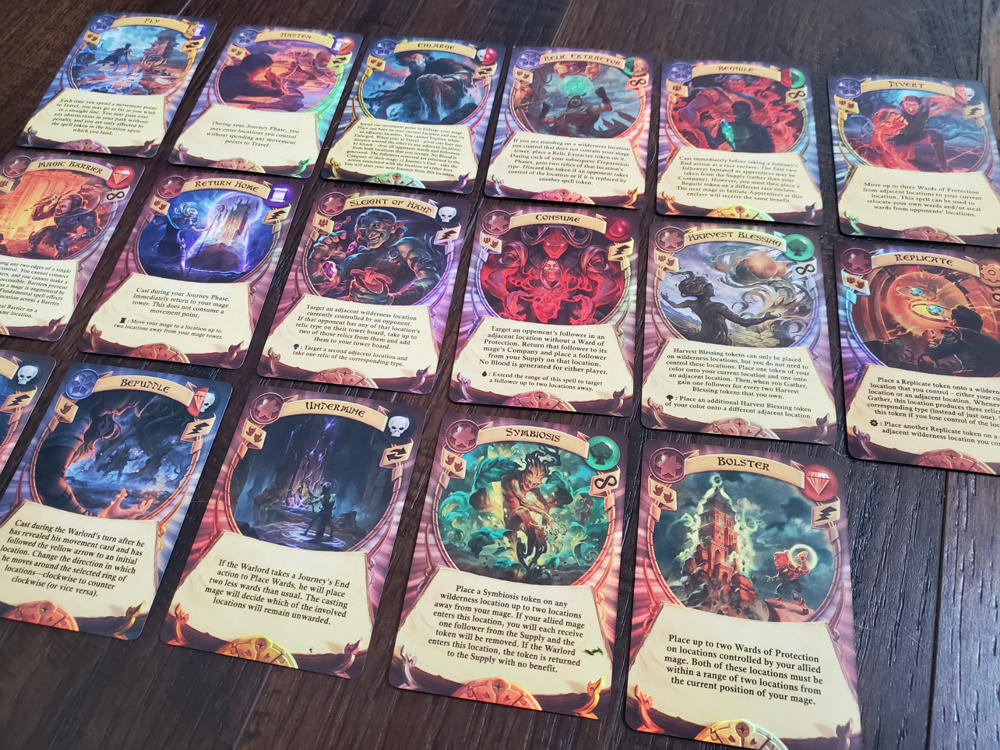
By only including two of the three levels of spells, it seems like an open admission that those highest level spells aren’t entirely useful for most of the game, providing something of a late round master’s degree worth a few extra points. The focus here remains on those first two stalwart levels.
But zoinks, what a set of spells! Directly addressing the super-tight economy of the base game, the Nature and Matter spells in Ascendant are specifically designed to release resources into the game well beyond the initial discovery of the terrain. The Time spells open doors to long-distance travel and incentivize maintaining chains of followers across the map.
The most exciting new spell has to be Enlarge, which comes with two massive boot meeples, allowing the mage to stand on two hex tiles simultaneously. Movement then comes by “walking” the boots around the map, one tile at a time (preferably with giant-sized narration). Attacks then fall upon both locations, making these boots worth chasing. In fact, I would go so far as to say most of the new spells are worth chasing and enable further chasing.
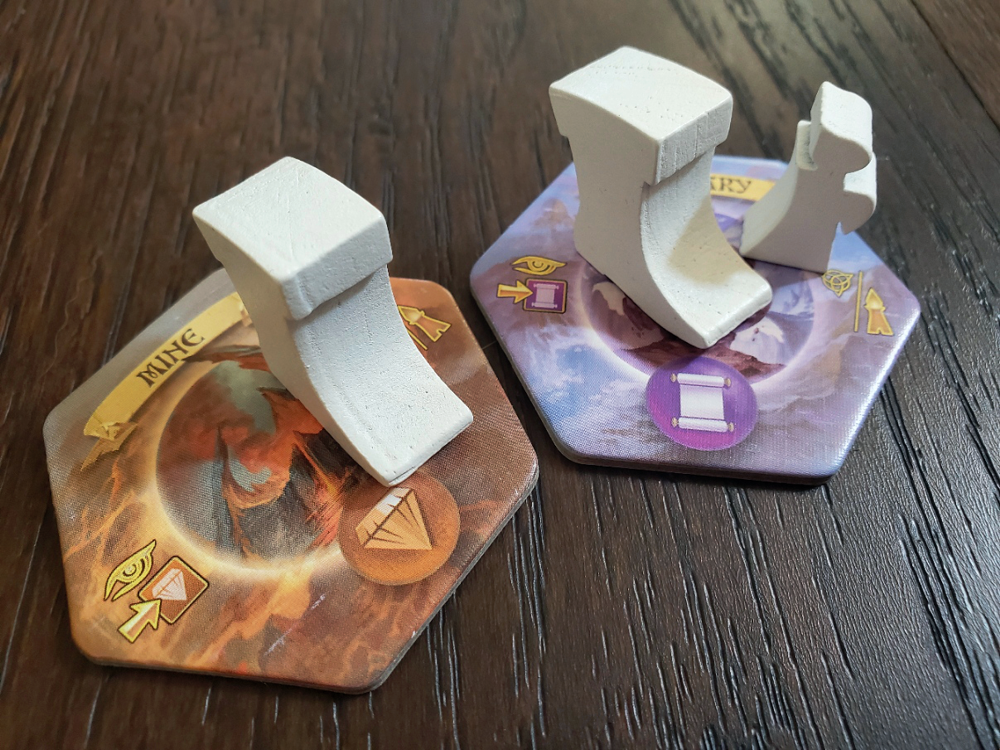
The Magic Barrier spell allows for the placement of permanent barrier bits in pairs around the map. These barriers implore mages to build effective defenses around their most lucrative tiles. Though these cannot be used to entirely enclose spaces, they can be used to make life challenging for any would-be attackers.
Couple all of this action with the new Surrender action, which allows one mage to pass through another mage’s space for the cost of one “converted” follower, and you have the sort of activity increase that leads to feelings of productivity and effectiveness that the base game sorely needed. Easier movement and easier resource collection remove all the right shackles from the system.
Planet Fitness
Six new tiles join the map layout as Places of Power. These tiles grant their possessor some fantastic abilities at different intervals. “Invest” followers so that they double in the following round, gather two resources instead of one at the beginning of the round, issue wards of protection apart from the usual rules, and travel across the map in a single bound. These are game changers, but none feels like it breaks the experience, especially as they change hands throughout the game.
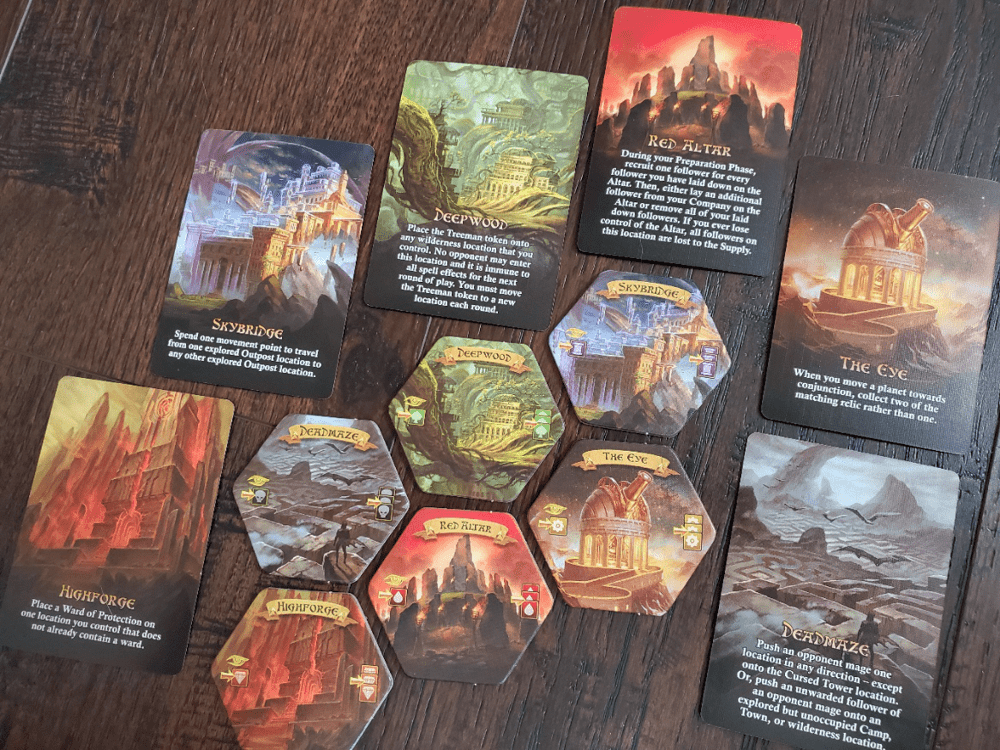
Of course, the most fun addition among these tiles is Deepwood and the acquisition of Treeman’s services. This Treebeard-ish meeple—easily a contender for one of my all-time favorite game bits—provides immunity for one tile from all spells and all opponent travel for one round. Of course, as long as players control Deepwood, they move Treeman during round maintenance. He’s wonderful.
Chasing Dreams
Prophecy cards are endgame objectives designed to prompt purposeful direction. These are subtle, but they are a great help. While players may choose to explore possibilities inherent in the game without so much as a gentle nudge, there can be a tendency from game to game to lean into the same spells, the same tiles, and thus, the same strategy. Prophecies break the cycle by sending mages out to accomplish a two-tiered task.
The first tier is easier and often worth only one point (remember 20 is a phenomenal score in Archmage, so one point matters). Control 10 adjacent locations. Possess 6 relics in each of 3 different types. These can happen by accident and are more a matter of paying attention to knock out the task when the iron is hot. The second tier is more difficult. Control 12 adjacent locations. Possess relics in each of 4 types.
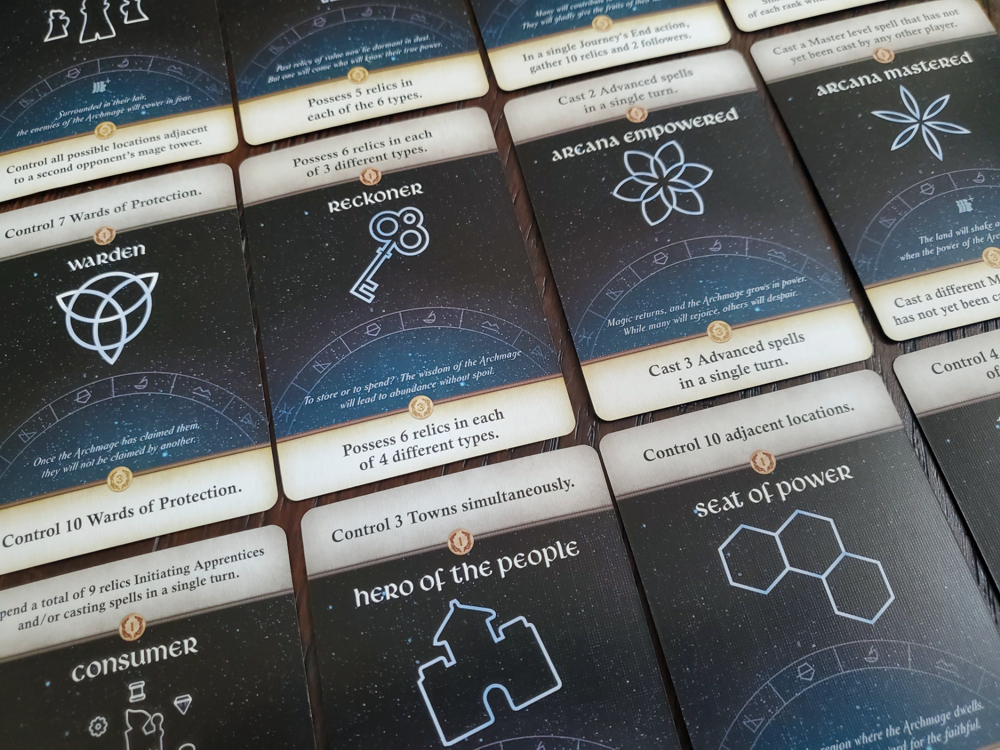
The twist to Prophecies: when the first tier is accomplished, the player may reveal the card and guarantee the lower points. However, in revealing the objective the other players might now attempt to stop the effort to hit the second tier. Of course, players can keep the card concealed while chasing the higher payoff, but if they never reveal the card, they never score the points. The risk and revelation add another layer of intrigue to the game’s story arc.
On the Rise
One year ago, I characterized Archmage as running with two concurrent storylines—the map and the mage tower. By introducing some of these new spells, there is a far greater and more consistent interactivity between the two lines. The spells now allow for the creation of something resembling an engine on the map, which increases attentiveness all around. The map subsequently opens doors for versatility in the spellbook, which makes the whole experience feel more cohesive.
One significant criticism of Archmage is game length. That has not changed with the addition of these materials. If anything the depth of the spellbook might demand a few extra minutes. I will say, though, that the minutes feel more fruitful, and fruitful minutes tend to better justify the number of minutes overall. I find the whole to be more engaging with these additions. In learning the expansion, I’ve enjoyed watching the other player turns to see what sort of system they can build.
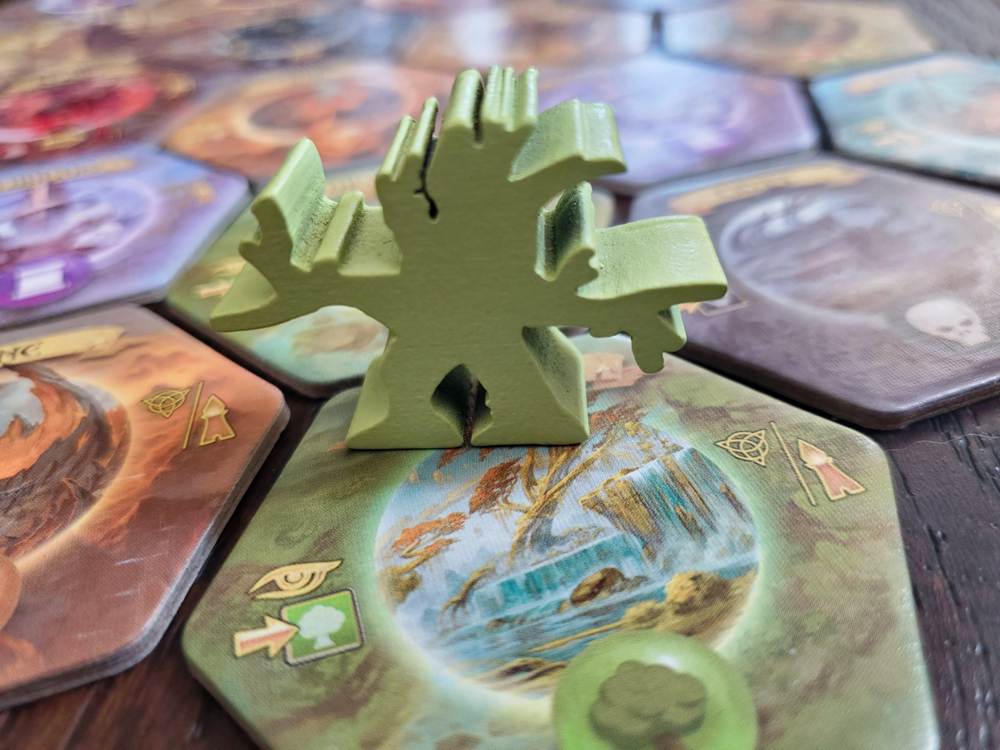
Some of the Prophecies, at first, feel downright impossible at their second tier. But I think that feeling (reasonably) stems from expectations set by the base game. In the days of old, there just weren’t enough resources to go around to accomplish such tasks. But a new day has dawned and chasing the more ridiculous feats has become rather exciting. I may still sneer when I read the card, but once I hunker down and get my pointy hat out, I find the tasks to be not only possible, but useful in their own way to achieving other ends.
We played a game recently where my eldest son built a harrowing network of magic barriers to protect his interest in Deepwood and Treeman. It was a beautiful feat in my opinion. He managed his prophecies well, kept a network of viable travel spaces open, and promoted his followers through the spellbook to victory. In the same game my youngest son chased and held four of the Places of Power to bolster his supplies and accomplish his second-tier Prophecies with enough board spaces to remain competitive. I spent the game building a resource engine on the board to feed a wide run through the spellbook, including those big ‘ol boots I adore. Three separate but equally viable pursuits were active on the board. It was fun to watch.
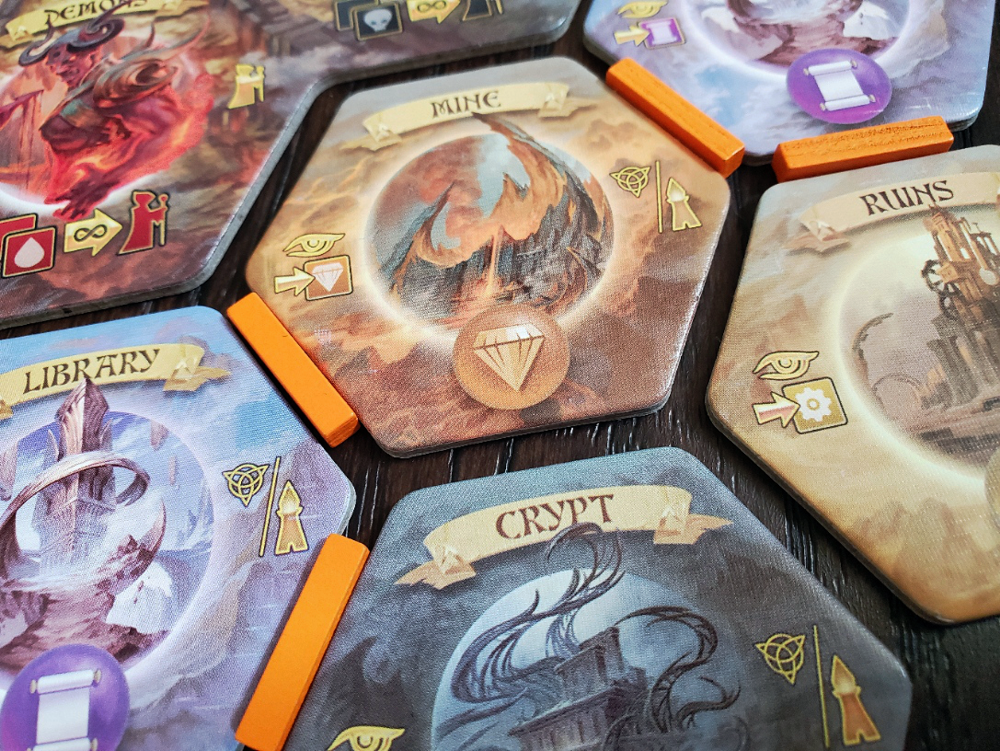
Ascendant is an interesting expansion to classify. For the player that just didn’t like Archmage, I’m not sure the new bits will flip that script—the core mechanisms are still the heart and soul of the experience. For those who were on the fence, I believe Ascendant loosens the economic belt just enough to tip the scales with all the new possibilities. For the fan, I think this second box is a no-brainer for the way it vivifies the personality of the game. The new concepts and components provide the right sort of beef without trampling the original.
I’ve not explored the co-op and solo variants as of this writing. I can see the boys enjoying a co-op dive at some point, and if I do so I’ll be sure to add to the report. But our default is the competitive mode, and this game has a very particular audience in the house. There are a half-dozen new spells specific to battling the Warlock, though, so rest assured there are materials for you if that’s your jam.
Overall, Ascendant is the sort of expansion I can get behind: honor the base experience, give depth to the personality of the game, and match challenge with possibility. If Archmage is anywhere near your wheelhouse, it’s worth a look. The greatest hindrance at this point is availability and, therefore, price. I’m hoping a few more copies make their way to the marketplace, because I can see folks enjoying the lift.





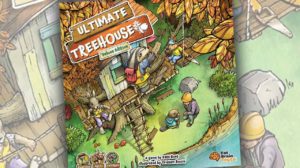






Add Comment